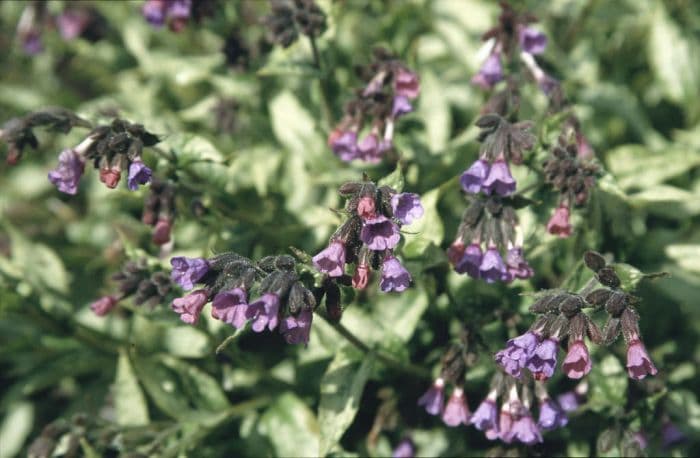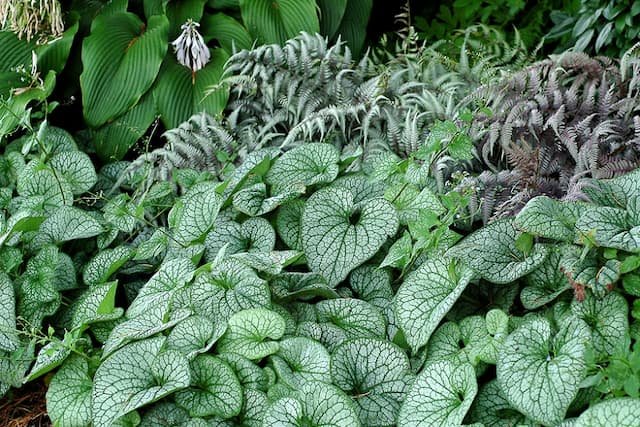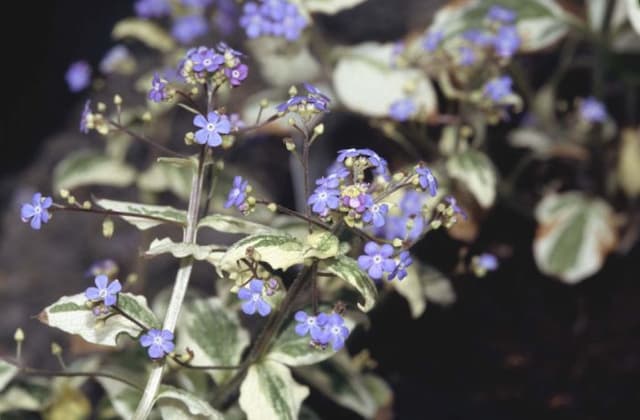Lungwort Pulmonaria 'Cotton Cool'

ABOUT
The Pulmonaria 'Cotton Cool' is a perennial plant known for its attractive foliage and delicate flowers. The leaves are particularly striking, as they have a unique silver-white dusting that almost looks frosted, overlaid on a deep green base. This dusty sheen makes the textured leaves appear to shimmer, especially in the right light. As the seasons change, the leaves can shift and develop more green, but that silvery overlay is generally persistent. In spring, the plant blooms with clusters of small, bell-shaped flowers in a range of colors from pink to blue. This color change in the flowers is quite enchanting; they often start as one color, typically pink, and fade to a purplish blue over time. The blossoms are dainty and add a pop of color contrasting beautifully against the cool-toned foliage, creating an eye-catching display in the garden. The overall growth of Pulmonaria 'Cotton Cool' is bushy, with leaves that create a low mound of foliage. The texture of the leaves is rougher rather than smooth, with a slightly hairy surface that contributes to the 'cotton' reference in the plant's name. This particular variety is appreciated for its decorative appearance and the multicolored effect it brings to garden spaces.
About this plant
 Names
NamesFamily
Boraginaceae
Synonyms
Lungwort, Bethlehem Sage, Jerusalem Sage, Soldiers And Sailors
Common names
Pulmonaria 'Cotton Cool'
 Toxicity
ToxicityTo humans
Pulmonaria 'Cotton Cool', commonly known as lungwort, is not considered toxic to humans. There are no well-documented cases of poisoning from consuming lungwort, and it is not listed as a poisonous plant by major health organizations. As with any plant, individual allergies or sensitivities may exist, so it is still advisable to exercise caution if you are not familiar with the plant.
To pets
Lungwort is also not known to be toxic to pets. It is not listed in the databases of common poisonous plants for animals such as dogs and cats. While ingestion of any non-food plant can potentially cause mild stomach upset in some pets due to the novelty and fiber content, lungwort is not expected to cause serious or life-threatening symptoms of poisoning in pets.
 Characteristics
CharacteristicsLife cycle
Perennials
Foliage type
Semi-deciduous
Color of leaves
Mixed
Flower color
Blue
Height
1 feet 12 inches (30 cm)
Spread
1 feet 12 inches (30 cm)
Plant type
Herb
Hardiness zones
4
Native area
Europe
Benefits
 General Benefits
General Benefits- Attractive Foliage: Pulmonaria 'Cotton Cool' has variegated leaves that add texture and color to shady garden areas.
- Spring Blooms: It produces clusters of blue, pink, or white flowers in the spring, providing early nectar for pollinators.
- Shade Tolerance: This plant is well-suited to shade gardens and can thrive in areas where other plants might struggle.
- Drought Resistance: Once established, it can tolerate periods of drought, making it a low-maintenance choice for many gardeners.
- Disease Resistance: Pulmonaria 'Cotton Cool' is resistant to many common plant diseases, ensuring a healthy garden with minimal intervention.
- Ground Cover: Its spreading habit makes it an excellent ground cover option, helping to suppress weeds and stabilize soil.
- Wildlife Attraction: Its flowers attract butterflies and bees, promoting biodiversity in the garden.
- Hardiness: Pulmonaria 'Cotton Cool' is hardy in a range of climates, making it a versatile addition to many gardens.
- Non-Invasive: The plant is non-invasive, which means it won’t overtake your garden and can coexist with other plants.
- Easy Propagation: It can be easily divided and propagated to create more plants, which is cost-effective for gardeners.
 Medical Properties
Medical PropertiesThis plant is not used for medical purposes.
 Air-purifying Qualities
Air-purifying QualitiesThis plant is not specifically known for air purifying qualities.
 Other Uses
Other Uses- Lungwort 'Cotton Cool' can be used as a natural dye for fabrics, where the leaves and flowers may yield delicate colors.
- The plant acts as an early nectar source for bees and other pollinators when few other food sources are available in the garden.
- As a groundcover, Lungwort 'Cotton Cool' helps to suppress weeds by forming a dense foliage mat.
- Its variegated leaves can be used in floral arrangements as an attractive foliage contrast.
- Lungwort 'Cotton Cool' can be planted in containers for patios or shaded balcony gardens to add texture and color.
- The plant can be used in educational settings, like school gardens, to teach about native plant gardening and biodiversity.
- Lungwort 'Cotton Cool' can provide habitat for small garden fauna, such as beneficial insects and some amphibians.
- Used in theme gardens, such as fairy or fantasy gardens, its unique spotted leaves add an element of whimsy.
- Photographers and artists may use the distinctive patterned leaves and flowers as subjects in their compositions.
- The plant's durability in shade makes it a good candidate for planting under trees where many other plants may not thrive.
Interesting Facts
 Feng Shui
Feng ShuiLungwort is not used in Feng Shui practice.
 Zodiac Sign Compitability
Zodiac Sign CompitabilityLungwort is not used in astrology practice.
 Plant Symbolism
Plant Symbolism- Longevity: Pulmonaria, commonly known as Lungwort, is a perennial plant, symbolizing endurance and the passage of time.
- Healing: Historically, lungwort has been associated with medicinal properties, particularly in treating lung diseases, thus symbolizing healing and remedies.
- Protection: Lungwort's spotted leaves were thought to resemble lung tissue. In the Doctrine of Signatures, this indicated the plant could treat lung ailments, giving it a protective symbolism against illnesses.
 Water
WaterLungwort, or Pulmonaria 'Cotton Cool', should be watered deeply once a week during the growing season, ensuring that the soil remains evenly moist but not waterlogged. In hotter, dry periods, it may require water twice a week, using about one gallon per plant per watering session to saturate the root zone. During the dormant season, reduce watering to when the top inch of soil feels dry to the touch. Overhead watering should be avoided to prevent leaf diseases; instead, water at the base of the plant.
 Light
LightLungwort thrives in partial to full shade, making it ideal for spots under trees or in the dappled light of a woodland garden. Avoid placing it in direct afternoon sunlight as this can scorch the leaves and stress the plant. Morning light or filtered light throughout the day is optimal for the best growth and flowering.
 Temperature
TemperatureLungwort is hardy and can tolerate a wide range of temperatures; however, it prefers cooler conditions, thriving ideally between 60°F and 75°F. It can endure minimum temperatures down to around 20°F, but extreme cold or frost may damage the plant. During hot weather, extra mulch can help keep the root zone cooler.
 Pruning
PruningLungwort benefits from pruning to remove old, damaged, or diseased foliage and to promote air circulation, usually done after flowering in late spring or early summer. Deadheading spent blooms can encourage a second flush of flowers. Prune the plant back by about a third every few years to rejuvenate and maintain its shape.
 Cleaning
CleaningAs needed
 Soil
SoilThe best soil mix for Lungwort (Pulmonaria 'Cotton Cool') would be well-draining, humus-rich, and slightly acidic to neutral in pH, ideally ranging from 6.0 to 7.0. Incorporate plenty of organic matter such as peat moss or compost to enhance soil fertility and structure.
 Repotting
RepottingLungwort (Pulmonaria 'Cotton Cool') does not typically require frequent repotting and can be done every 3-4 years, or when it outgrows its current pot and the roots become cramped.
 Humidity & Misting
Humidity & MistingLungwort (Pulmonaria 'Cotton Cool') thrives in average to high humidity conditions; maintaining humidity levels around 50% or higher is beneficial for this plant.
 Suitable locations
Suitable locationsIndoor
Place Lungwort in bright, indirect light and maintain high humidity.
Outdoor
Plant Lungwort in part-shade, moist, well-draining soil.
Hardiness zone
4-8 USDA
 Life cycle
Life cycleLungwort 'Cotton Cool' begins its life cycle with seed germination, which occurs in the spring when conditions are moist and cool. The seedlings quickly develop into rosettes of silver-speckled leaves, which are evergreen and will persist through milder winters. In the following spring, mature Lungwort plants produce clusters of bell-shaped flowers that shift in color, from pink to violet-blue, as they age, attracting early-season pollinators. After flowering, the plant sets seed, enabling the dispersal and continuation of the species. Throughout the summer, Lungwort 'Cotton Cool' continues to grow vegetatively, with its leaves providing ground cover and interest. As a perennial, the plant then goes dormant in winter, with the root system surviving underground to re-sprout the following spring.
 Propogation
PropogationPropogation time
Early spring
Propogation: Pulmonaria 'Cotton Cool', commonly known as Lungwort 'Cotton Cool', is most commonly propagated through division in the spring or early fall. Division involves digging up the plant, carefully separating the clump into smaller pieces, ensuring that each new section has an adequate amount of roots and shoots. These sections can then be immediately replanted into a well-prepared garden soil, spaced approximately a foot apart to give them room to grow. Watering the new divisions thoroughly after planting helps them establish in their new location. This method is effective for lungwort because it helps rejuvenate older clumps that may have become woody or less vigorous, promoting more robust growth and flowering.









